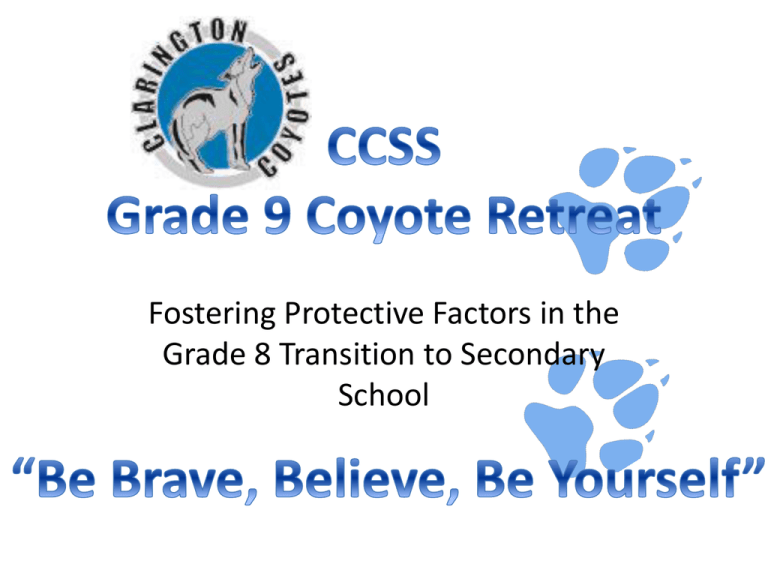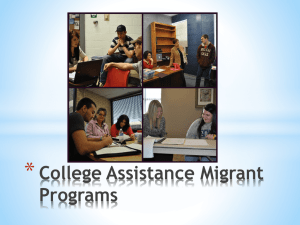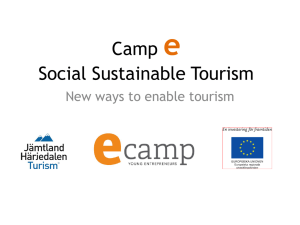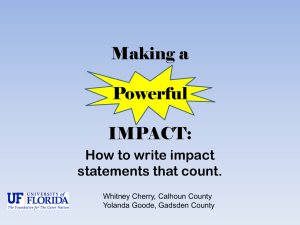CCSS Gr 9 Coyote Retreatx - Clarington Central Secondary
advertisement

Fostering Protective Factors in the Grade 8 Transition to Secondary School The Struggle • The transition to secondary school comes at a critical point in adolescent development and has potential long term effects. • Students who are unsuccessful in grade 9 are more likely to struggle throughout school and as young adults. • Grade 9 students struggle significantly with peer interaction, teacher interaction, attendance, mental health issues, bullying and falling academic performance, putting them “at-risk.” At-Risk As identified in the Early School Leavers Study (2005), an at-risk youth is one who is unlikely to successfully progress towards graduation with the skills and selfconfidence necessary to have meaningful options in the areas of work, leisure, culture, civic affairs, and relationships (cited in Tilleczek & Ferguson, 2007). Nested Transitions Tilleczek (2010) suggests the transition from elementary to secondary school is best described as a series of “nested transitions”: • From childhood to adulthood (physical and cognitive development); • Along pathways to success through schools, communities and families; • From elementary to secondary school within these larger transitions. The Paradox Want more independence and autonomy. Elementary School Need more support to navigate changes. Secondary School Self-esteem hangs in the balance • Self-esteem is the integrated sum of selfworth and self-competence. • Self-worth is strongly influenced by quality of relationships with others and the judgements we make about how we are living up to expectations. • Self-competence is related to our belief in our own coping skills. (Mruk, 1999 cited in Jindal-Snape & Miller, 2008). Jindal-Snape & Miller (2008) summarize a number of resilience and risk factors in their exploration of transition using resilience and self-esteem theories. Resilience Factors Self-esteem Locus of control social skills temperament personal awareness empathy parenting style parent relationship academic performance friend network Risk Factors 5 Areas Key to Transition • Decreasing the number of problems in child’s life, • Thinking of life as a developmental pathway, • Providing a secure base of attachments, • Fostering self-esteem, and • Facilitating self-efficacy by involvement in planning and preparation (Jindal-Snape & Miller, 2008). Literature Review • other comprehensive literature reviews • studies involving 1:1 interviews/written feedback • longitudinal surveys • meta studies in which survey data was complemented by school data Recommendations • Foster school attachment. • Provide opportunities to form and reinforce positive relationships with peers. • Create opportunities for relationship building and mentoring by senior students and caring adults. • Decrease anticipation stress of adolescents (and families) by providing accurate information about expectations, school structure, and strategies. • Increase feelings of competency by providing opportunities to achieve success and practice skills • Collaborate with families to support adolescents. • First week of school; seniors go Wed, gr. 9s Thu/Fri. • Senior mentors meet grade 9s at camp and give out CCSS t-shirts, the unofficial camp uniform • Grade 9s and student and teacher mentors participate in a variety of activities, each followed by a debriefing session ice breakers GLO motivational & problem solving activities high & low ropes challenges • Highlight: motivational speech by Stu Saunders The Goals of the Activities • Team building • Goal setting • Forming relationships with peers, seniors and staff • Leadership • Personal development and awareness • Understanding “High school is what you make of it” • Inclusive community building • Embrace diversity • Peer support • Cultivating sense of belonging What we experienced … • Staff • Senior mentors • Grade 9s What happened later … • Continued positive relationships between grade 9s and the staff and seniors who attended the camp • Lots of CCSS t-shirts in the halls • Dramatic reduction in the course failure rate between first semester this year and last for grade 9 students. (Only 19 grade 9 students failed courses at the end of semester 1, vs. 44 previous year.) • Reduction number of suspension days for grade 9 students. • Substantial drop in truancy rate for gr. 9s in semester 1 over the previous year. (Reduced by half.) • At risk students who did not go to camp still face the most challenges Credit Accumulation First Camp Cohort Second Camp Cohort Semester 1 Failure Rates Students Grade Total Failed 1 2011/12 9 224 2010/11 9 222 2009/10 9 255 2008/09 9 271 2011/12 10 231 2010/11 10 254 2009/10 10 278 2008/09 10 301 Semester 2 Failure Rates Students Grade Total Failed 1 2011/12 2010/11 9 225 2009/10 9 256 2008/09 9 271 2011/12 10 2010/11 10 255 2009/10 10 273 2008/09 10 302 Failed >1 11 19 44 36 16 34 57 39 Credits Possible Failure 9 896 3.35% 5 888 3.15% 20 1020 8.14% 19 1084 6.64% 25 924 8.88 16 1016 5.91% 21 1112 8.54% 15 1204 5.65% Credits Possible Failed >1 Failure 14 16 25 15 25 23 900 1024 1084 5.56% 8.98% 8.39% 19 21 27 21 39 22 1020 1092 1208 7.06% 12.04% 6.54% Suspensions First Camp Cohort Second Camp Cohort Sem 1 2011/12 2010/11 2011/12 2010/11 Grade 9 9 10 10 Total # # of Repeats Avg # of Days 9 2 3.5 16 8 3 9 1 2 24 5 3 Median # of Days 3 3 1 2 Sem 2 2011/12 2010/11 2011/12 2010/11 Grade 9 9 10 10 Total # # of Repeats Avg # of Days Median # of Days 10 5 3 1 20 11 3 3 Attendance First Camp Cohort Second Camp Cohort total year number % total days total days total days grade students truant truant absent late excused 2012 9 2011 9 216 31 14% 450 202 48 2010 9 248 61 26% 933 409 77 2009 9 271 64 24% 771 347 99 2012 10 2011 10 243 74 30% 941 424 87 2010 10 253 98 39% 1784 568 170 2009 10 302 128 42% 1677 472 188 The CCSS Grade 9 Retreat 2011 and 2011 and Follow up • Expanded senior mentor training and role facilitated by The Beanstalk Project – www.thebeanstalkproject.org • Integration of leadership/teambuilding workshops in programming for those not attending • Follow up motivational session mid-September by Beanstalk Project for all grade 9s • Afternoon workshops with the Beanstalk Project for Shining Stars from Camp and Students who did NOT attend camp • Follow up video presentation by Beanstalk Project facilitated by mentors in home rooms What happened next … • Increased participation • More of the same – fewer failures, better attendance, fewer teacher concerns • How do we pull in the students who we already know are at risk and refuse to attend camp? Looking Ahead to 2012 • Grade 8 Fantastic Fridays • Addition of CCSS led workshops to camp schedule, e.g., mental health awareness and resources • More mentor programming throughout the school year • Incorporation of elements of the IPP into the follow up work with mentors and teachers Nuts & … • Approximately 2/3, ¾ have attended – 180 grade 9s, 20 senior students, 18 staff • Grade 9s pay $100 each with poverty intervention and contests for bursaries • Senior students and staff do not pay • Seniors help facilitate activities and supervise cabins; many offer high school 101 in cabin • Singing, skits etc. are encouraged at camp fire … Bolts • Teacher participation is voluntary and includes admin, guidance, co-op, EAs as needed • Teachers with grade 9 classes either go to camp, do on-calls for others who go to camp, or provide/supervise program for students who do not attend camp • Everyone needs to bring sleeping bag, pillow, towels, flashlight, cold and wet weather gear – we play rain or shine! Facilities: www.ylcc.com • YLCC Orillia can accommodate approx. 300 overnight, Pigeon Lake approx. 120; cabins with bunks and mattress sleep up to 20; common washroom facility • YLCC Camp counsellor ratio is approx. 1:15 with more staff on hand; all fully trained and safety certified • All meals provided; nut free • Facilitated activities run from 7:30 flagpole to 11pm • Facilities include high and low ropes, rock wall, fixed and non-fixed initiatives, grassy fields, wooded area, camp fire ring, beach & kayaks • Separate teacher cabins w/washroom sleep up to 12 • Special needs can be accommodated Promotion • Promotion during January feeder school visits and Grade 8 Parent Night • Posters and permission forms go out with draft timetables in June • Summer reminders through e-mail, Synervoice • Forms and money collected on Orientation Day and up to Camp Day T-shirt Design Contest Win your trip to camp! Organization • Permission forms and money collected by feeder schools and forwarded to CCSS – NOT processed by feeder schools • Forms and money collected on Orientation Day and up to Camp Day • One teacher goes with senior students a day early for training • Students assigned to cabins such that at least 2 students from any given feeder school are in a cabin – everyone knows someone • Students permitted to request a cabin mate if necessary – few do • Cabins are assigned to buses • Grade 9s report to the foyer on the morning we leave and find their names on alpha lists which indicate cabin and bus number • Bag checks are done as students board buses • YLCC plans everything else! The Bottom Line Coyote Retreat • Camp fees • Bussing • T-shirts and prizes $16 000 3 000 1 000 The Beanstalk Project Mentoring Program 3 500 • Includes 2 x full day workshop • 1 video module The Last Word Questions Reading & Resources www.claringtoncentralss.ca Select Guidance, Grade 9 Transition Model To view complete proposal and PowerPoint heather_newton@kprdsb.ca







